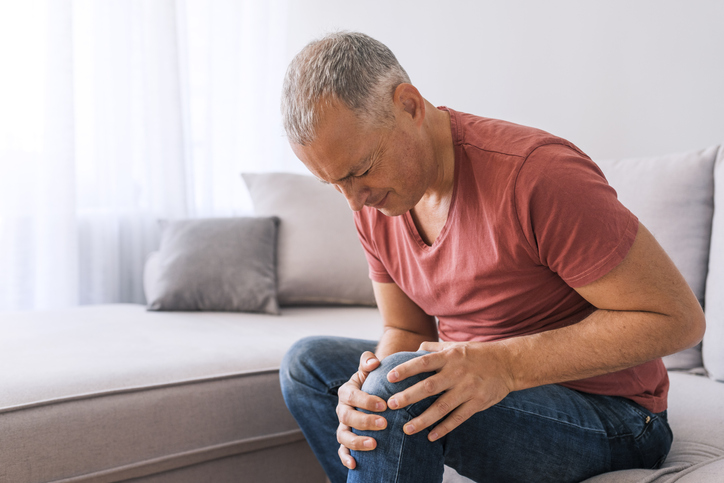Pain
Common Types of Leg Pain

Leg pain
Leg pain can affect the entire leg or a specific area, such as the knee, shin or thigh. Mild leg pain can be intermittent and sore after certain activities, while severe pain can limit weight-bearing or physical activities. Leg pain can be caused by wear and tear, overuse, or injuries to the joints, bones, muscles, tendons or ligaments.
Types of leg pain
Everyone may experience leg pain differently. Burning pain may radiate from the buttocks or low back, and down the leg. It may be described as shooting, intermittent, or electric pain that feels like a sudden, sharp jolt.
Numbness or tingling often feels like the leg has fallen asleep and then returns to normal. However, unlike when a limb normally falls asleep, low back pain or numbness can be chronic and may affect daily life. There are various types of leg pain. The following is a list of the most common types of leg pain.
Muscle cramps
Muscle cramps are sometimes caused by dehydration and can easily be treated by drinking additional water. Sports drinks can help replace electrolytes. It may also help to gently massage the painful area when a muscle has tensed up. Consult a health care professional if muscle cramps are severe and occur frequently.
Delayed onset muscle soreness, or DOMS, is a muscle pain that can range from tenderness to severe. It appears hours or days following physical activity. The cause is unknown; however, it is most common when beginning a new activity after a period of inactivity. Nonsteroidal anti-inflammatory drugs (NSAIDs) and avoiding extra activities for a few days can help.
Shin splints
Shin splints occur when the muscles and tendons located underneath the shin bone become damaged or inflamed, causing difficulty walking. People who have flat feet or walk with their feet turned outward may be at an increased risk of shin splints. Resting and icing usually help improve this condition.
Tendinitis
Tendinitis, or tendonitis, is the inflammation or irritation of a tendon. Tendons are thick fibrous cords that attach muscles and bones. Tendinitis is either acute or chronic and can develop in any tendon. The affected joint may become difficult to move. Tendinitis typically presents with pain and tenderness in the affected area.
Pain in the lower half of the leg may be a result of tendonitis. This could be caused by swollen or torn tendons near the back of the heel or in the lower calf. It occurs as a result of the legs being overworked or from climbing stairs. Conventional treatments include icing the area to reduce inflammation and resting for a few days. Severe pain may be an indication of a torn Achilles tendon, in which case a health care professional will likely inject medicine into the area. In some situations, surgery may be necessary.
Sprain
A sprain results when a ligament is stretched or torn. A ligament is a band of tissue connecting bones in a joint. Although a sprain can occur at any joint, the most common are ankles, knees and wrists. Sprains typically result from twists and falls, rolling the ankle, or receiving a hit that forces the body out of its normal position.
A twisted ankle or mild sprain can be treated by resting, icing, compressing and elevating the leg, in that order. A more severe sprain or a broken bone may need to be put in a cast to heal properly. Physical therapy may also be necessary.
Blood clots
Leg pain that comes on suddenly, is sharp or severe, and is accompanied by swelling and tenderness in one leg could be a blood clot, which is a life-threatening condition. Blood clots are medical emergencies and occur when the blood thickens and clumps together in a vein. Deep vein thrombosis arises when a blood clot forms in a vein that is located deep in the body, such as the lower leg or thigh. They tend to appear as a result of inactivity for long periods of time, such as in a car ride or on a flight. Smoking, being overweight, and certain medications also increase the risk.
Varicose veins
Varicose veins are caused by weak vein walls and valves. They may cause a dull ache after standing for extended periods of time. Support stockings are available to help relieve the pain. Exercise may also assist in strengthening the leg muscles.
Nerve pain
The nervous system is responsible for delivering critical signals throughout the body. The spinal cord is the nerve center of the body; nerves from all over the body enter and exit through the spinal cord. It transfers signals from the brain to the nerves and from the nerves to the brain.
Spinal stenosis is a narrowing of the spinal canal that causes pressure on nerves traveling to the legs and arms. Some people are born with the condition, while others have wear-and-tear on the vertebrae (spine bones). Some people do not show any symptoms, while others feel pain, numbness, tingling, muscle weakness, and problems controlling bladder and bowel functions.
Sciatica, or sciatic nerve pain, refers to pain that occurs when the sciatic nerve root in the lower back becomes compressed, irritated or inflamed. Sciatic nerve pain radiates from the lower back, into the buttocks, and down the legs. It is most commonly the result of a herniated or slipped disc, bone spurs, or spinal stenosis. The type of sciatica is dependent upon one or both legs being affected and the duration of symptoms. Sciatica types include acute, chronic, alternating and bilateral.
Warning
Individuals should seek medical attention if leg pain is severe or lasts longer than a few days. Seek emergency medical attention if a crack is heard, motion is impaired, severe swelling occurs, or headache, numbness, weakness or tingling accompany the leg pain.






